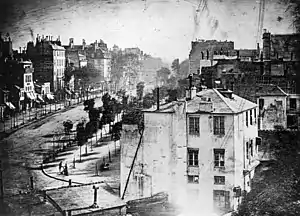
Boulevard theatre is a theatrical aesthetic that emerged from the boulevards of Paris' old city.[1][2]
Origin
Starting from the second half of the 18th century, popular and bourgeois theatre alike took up residence on the boulevard du Temple, then nicknamed 'boulevard du Crime' due to the many melodramas and murder stories shown there. In addition to the many attractions on display there – fireworks, pantomime, acrobats, etc. – a so-called 'boulevard' repertoire emerged separate from upper-class theatre. Then, starting from the Second French Empire, vaudeville theatre and comédie d'intrigue arrived on the scene.
Style
Boulevard theatre consists mostly of comedies but also dramas. In general, the characters are simply drawn, ordinary or easily understandable. There is a strong tendency to avoid touchy subjects, such as politics and religion. The style is not designed to challenge preconceived ideas or offend. Examples include such sex comedies as La Cage aux Folles and Boeing Boeing.
Feydeau
Georges Feydeau, most active between 1890 and 1920, often produced up to the 21st century, is a boulevard theatre playwright whose satiric plays often take aim at adulterers and libertines in a manner not generally seen in British theatre of the same era.
List of playwrights
- Marcel Achard
- Jean Anouilh
- Émile Augier
- Marcel Aymé
- Pierre Barillet
- Henry Bataille
- Henry Becque
- Tristan Bernard
- Henri Bernstein
- Paul Bilhaud
- Alexandre Bisson
- Henri-Frédéric Blanc
- Édouard Bourdet
- Alexandre Breffort
- Marc Camoletti
- Isabelle Candelier
- Alfred Capus
- Gaston Arman de Caillavet
- Henri Chivot
- Jean Cocteau
- Georges Courteline
- Henry de Gorsse
- Lucien Descaves
- Jacques Deval
- Maurice Donnay
- Françoise Dorin
- Alexandre Dumas, fils
- Georges Feydeau
- Robert de Flers
- Edmond Gondinet
- Jean-Pierre Gredy
- Roger Ferdinand
- Sacha Guitry
- Thomas-Simon Gueullette
- Maurice Hennequin
- Albert Husson
- Eugène Labiche
- Henri Lavedan
- Julien Luchaire
- Claude Magnier
- Félicien Marceau
- Georges Mitchell
- Marcel Mithois
- Maurice Ordonneau
- Marcel Pagnol
- René Charles Guilbert de Pixérécourt
- Jean Poiret
- Georges de Porto-Riche
- Claude-André Puget
- Jules Romains
- Edmond Rostand
- André Roussin
- Armand Salacrou
- Victorien Sardou
- Jean Sarment
- Eugène Scribe
- Robert Thomas
- Albin Valabrègue
- Francis Veber
- Pierre Veber
- Louis Verneuil
- Pierre Wolff
- Maurice Yvain
References
- ↑ Barrot, Olivier; Chirat, Raymond. Ciel, mon mari ! Le théâtre de boulevard. Paris: Découvertes Gallimard, N° 359, 1998. ISBN 2070533824
- ↑ Brunet, Brigitte. "Le Théâtre de Boulevard". French Studies 59: 417–418, July 2005